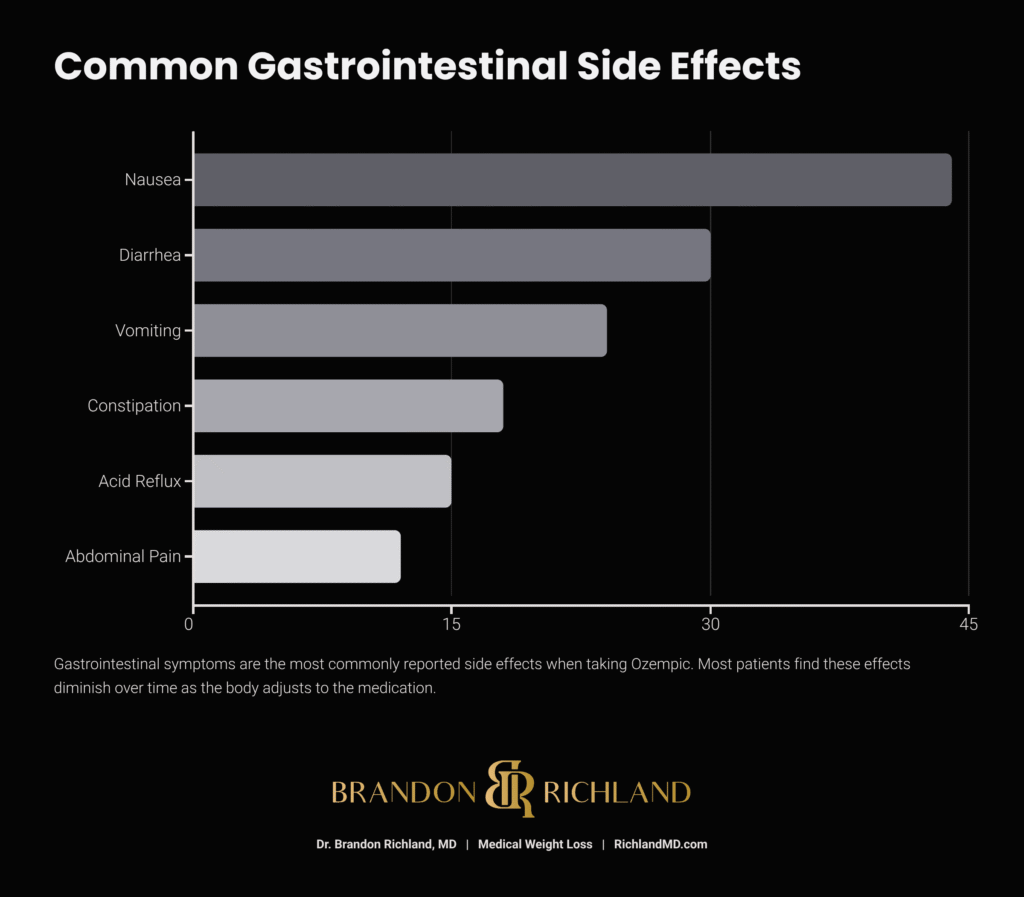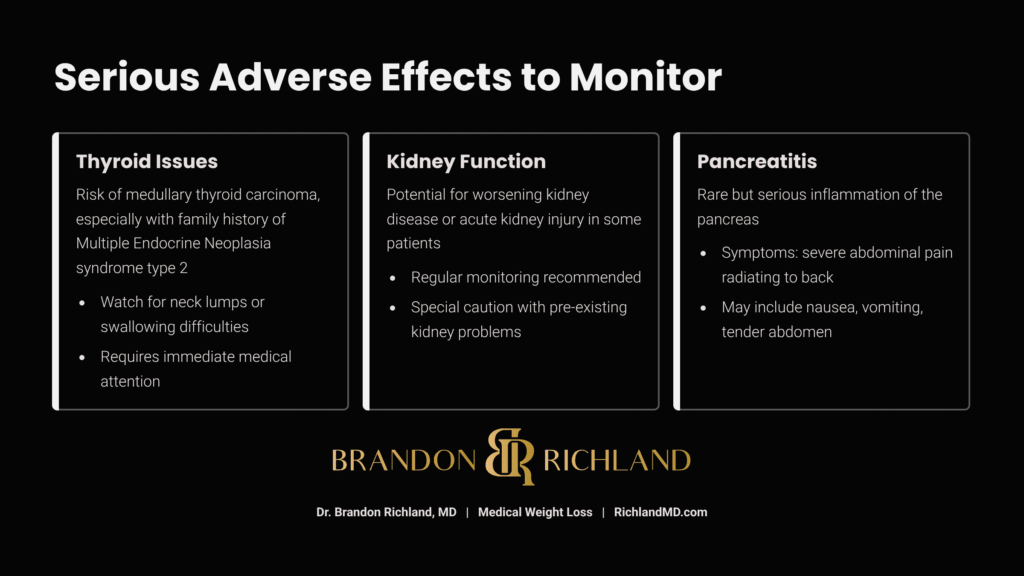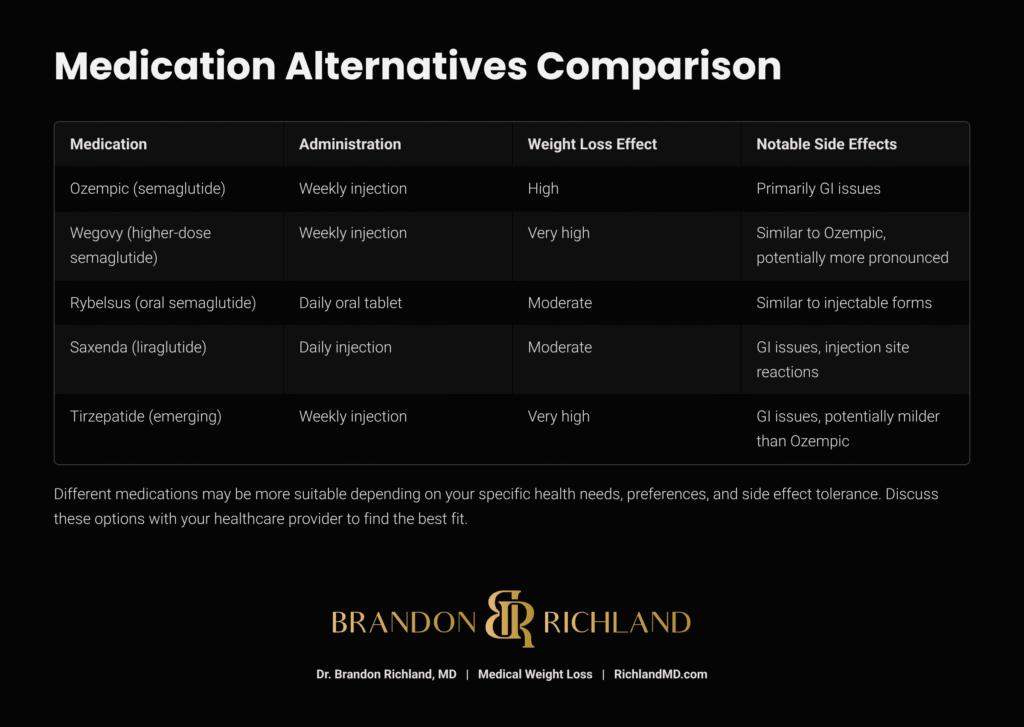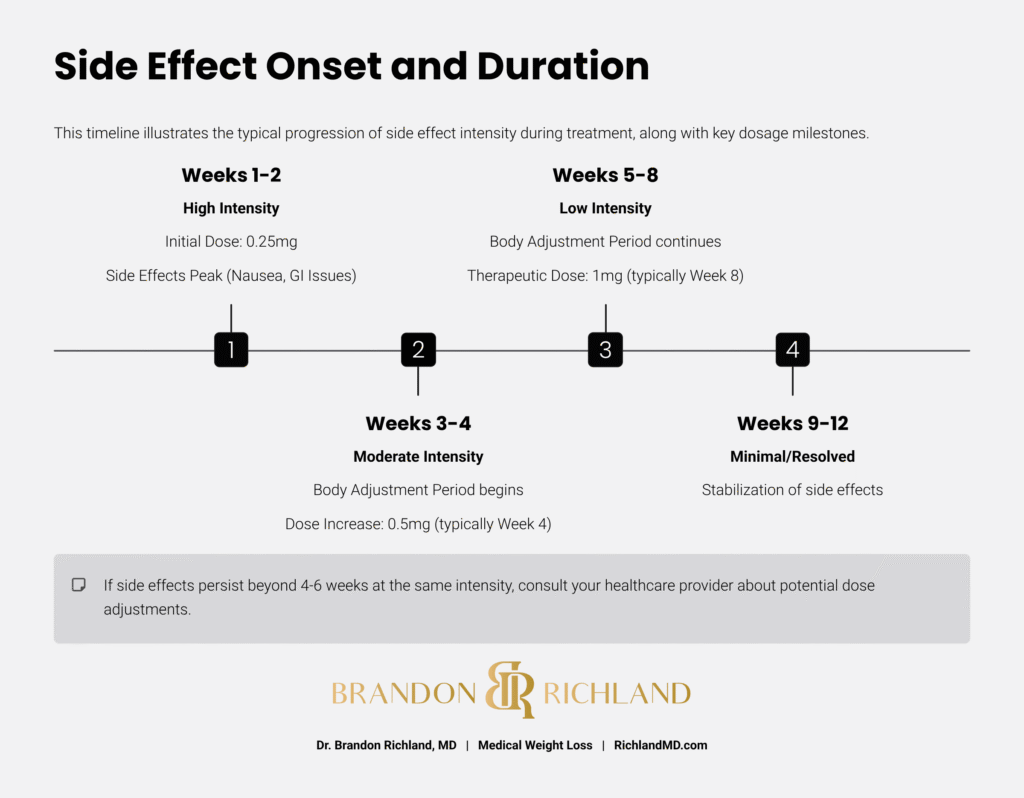Published by Dr. Brandon Richland, MD

Ozempic, known generically as semaglutide, is a medication approved for the management of type 2 diabetes. It operates by mimicking a hormone that induces insulin production and helps lower blood sugar levels. The FDA has updated Ozempic’s labeling to include warnings about intestinal blockages, a serious gastrointestinal condition called ileus.
Beyond its primary use, Ozempic has also been recognized for its role in weight loss, making it a versatile tool in diabetes care. While it can offer significant benefits for controlling diabetes, it’s also associated with a range of side effects that patients should be aware of. Studies have identified potential vision complications, including nonarteritic anterior ischemic optic neuropathy (NAION), among users of semaglutide medications.
Understanding the side effects of any medication is crucial, and Ozempic is no exception. Many patients experience common side effects such as gastrointestinal disturbances, while others may encounter more severe reactions that can affect different body systems or lead to allergic reactions.
Key Takeaways of Ozempic Side Effects
- Ozempic treatment aids in blood sugar control and weight loss for those with type 2 diabetes.
- Side effects range from mild gastrointestinal disturbances to severe conditions affecting various body systems.
- Patients must be informed about managing side effects and understanding drug interactions and dosing.
- The FDA has issued warnings about ileus, a potentially life-threatening bowel obstruction condition linked to Ozempic use.
- Emerging research suggests possible connections between semaglutide and vision changes, including diabetic retinopathy worsening and macular complications.
- Clinical studies indicate a slightly elevated risk for gallstones and gallbladder infections among Ozempic users compared to placebo groups.
Ozempic and Its Uses
Ozempic, known by its generic name semaglutide, has emerged as a significant prescription medication in the management of type 2 diabetes. It is recognized not just for its role in regulating blood sugar levels but also for its potential benefits in weight loss among diabetic patients. However, injection site complications have been documented, including subcutaneous nodules described as hard lumps or masses at injection sites.

Mechanism of Action in Blood Sugar
Ozempic works by imitating a hormone called glucagon-like peptide-1 (GLP-1), which is integral to regulating blood sugar. The injection enhances the body’s ability to produce insulin when blood sugar levels are high. Ozempic slows down digestion, leading to a more gradual uptake of glucose into the bloodstream.
Benefits for Diabetes Management
Patients with type 2 diabetes may find substantial benefits from incorporating Ozempic into their health care regimen. The drug’s ability to stabilize blood sugar and its associated effect on weight loss can be a dual advantage.
Health care providers often highlight the importance of maintaining a healthy weight, as it can improve overall diabetes management. It is essential for individuals to discuss the potential advantages and appropriate usage of Ozempic with their health care provider to ensure it aligns with their specific health needs. European regulatory findings have confirmed NAION as a very rare side effect of semaglutide medications, requiring careful monitoring.
Kelly Clarksons journey toward wellness is often highlighted as a success story. Her transformation also brings up questions about the effectiveness of Ozempic as a weight loss aid.
Common Side Effects of Ozempic
When starting treatment with Ozempic, patients may experience a range of side effects, particularly in the gastrointestinal and metabolic systems. Understanding these reactions helps in managing them effectively.

Gastrointestinal Side Effects of Ozempic
Nausea: Individuals taking Ozempic often report feelings of nausea, which may diminish over time.
Vomiting and Diarrhea: Episodes of vomiting and diarrhea are also relatively common Ozempic side effects but should be monitored to ensure they do not lead to dehydration.
- Constipation: Some patients might experience constipation, urging a review of diet and fluid intake.
- Gas and Indigestion: Increased gas or indigestion can be unpleasant side effects that may occur.
Acid Reflux and Belching: Acid reflux and frequent belching may be experienced, which are manageable with dietary adjustments.
Bloating and Flatulence: Patients may report feelings of bloating and increased flatulence as their body adjusts to the medication.
Metabolic Reactions
Metabolic changes are another aspect to watch for in patients taking Ozempic. Although not as frequent as gastrointestinal issues, awareness of them is important for comprehensive care.
For more detailed information and assistance with managing these side effects, patients should consult their healthcare providers.
Serious Adverse Effects
While Ozempic is a medication that can help manage blood sugar levels, certain serious adverse effects warrant attention. Understanding them is crucial for ensuring prompt medical intervention if necessary. Research has documented increased risks of serious gastrointestinal conditions, including a 4.22 times higher risk of bowel obstruction.
Endocrine System Concerns
The endocrine system can be notably impacted by Ozempic, particularly through the potential development of thyroid tumors, including medullary thyroid carcinoma. Patients need to be vigilant for symptoms such as a lump in the neck or difficulty swallowing.
Furthermore, it is advised for patients with a family history of Multiple Endocrine Neoplasia syndrome type 2 to avoid using Ozempic due to the increased risk of medullary thyroid cancer.
Patients with a family history of these conditions should discuss risk factors with their healthcare provider before starting Ozempic.
Cardiorenal Issues
Those taking Ozempic may also experience cardiorenal issues, with cases of worsening kidney disease or acute kidney injury reported. The drug has been known to exacerbate pre-existing kidney problems, and caution should be exercised.
Additionally, careful monitoring is essential for patients who have a history of kidney failure, heart attack or stroke as managing cardiovascular health is critical when on Ozempic treatment. Although it helps control blood sugar, vigilance is important for those with hypoglycemia risks or conditions that affect the gallbladder.

Potential Serious Allergic Reactions
While Ozempic is effective for managing diabetes, patients should be aware of the risk of allergic reactions. These reactions can range from mild to severe and require prompt attention.
Recognizing Allergic Symptoms
Hives: Characterized by raised, red, itchy welts on the skin, hives are a common sign of an allergic reaction to medications like Ozempic.
Swelling: Patients may notice swelling around the face, lips, and tongue, which can be a cause for concern.
Difficulty Breathing: Allergies can lead to trouble swallowing or a hoarse voice, indicating swelling in the throat or airways.
Itching: This usually affects the whole body and can be an early indicator of a hypersensitivity response.
If patients experience these symptoms, they should seek medical assistance immediately, as they may represent a serious allergic response to Ozempic.
Influence on Other Body Systems
Ozempic, while primarily used to manage blood sugar levels in people with type 2 diabetes, can also impact other body systems. This medication may lead to skin-related side effects as well as gastrointestinal reactions, each of which varies by patient.

Dermatological Effects
Patients may experience dermatological effects while taking Ozempic. One notable reaction is the development of a skin rash, which could denote an allergic response to the medication. It’s essential to monitor any changes in the skin’s condition, including rashes, to ensure they are managed appropriately.
Gastrointestinal Reactions
Ozempic’s influence on gastrointestinal functions often includes symptoms such as nausea, diarrhea, and vomiting. Stomach and abdominal pain are also reported by patients. Although rare, gastrointestinal issues like ileus, characterized by a lack of movement in the intestines, may occur. Patients experiencing such symptoms are advised to consult their healthcare provider.
Managing Side Effects
When patients experience side effects from Ozempic, they can often manage them effectively through diet and lifestyle adjustments, as well as medical interventions. These strategies focus on mitigating common issues such as nausea, vomiting, and fluctuations in blood sugar levels that may lead to health complications like diabetic retinopathy.
Diet and Lifestyle Adjustments
Incorporating specific dietary changes can help alleviate Ozempic side effects. For instance, they should:
- Eat smaller, more frequent meals to reduce nausea.
- Include foods that stabilize blood sugar levels to prevent peaks and troughs that can contribute to fatigue.
Regular exercise can also improve blood sugar control and overall health, but patients should speak with their healthcare provider about an appropriate exercise regimen, especially if they experience tiredness or fatigue as a side effect of the medication.
Medical Interventions
Medical interventions may be necessary if diet and lifestyle adjustments aren’t fully effective. Patients might consider:
- Medication adjustments: Sometimes, altering the dosage of Ozempic under medical supervision helps manage side effects.
- Monitoring blood sugar: Careful monitoring can help prevent episodes of low blood sugar (hypoglycemia), especially for those taking other diabetes medications. Severe hypoglycemia, or severe low blood sugar, are critical concerns, especially when Ozempic is combined with other diabetes drugs. Symptomatic hypoglycemia can manifest as blurred vision, dizziness, and even loss of consciousness.
Healthcare providers can offer additional support, such as prescribing antiemetic drugs to control nausea or providing recommendations tailored to the patient’s health status.
Drug Interactions and Contraindications
When considering the use of Ozempic (semaglutide), it’s important to be aware of potential drug interactions and contraindications. Identifying medications that could negatively interact and conditions that may be exacerbated by Ozempic is essential for the safety and health of the patient.
Medications to Avoid
- Oral Medications: Ozempic can slow gastric emptying, which may impact the absorption of orally administered medications. Patients should be cautious and consult their healthcare provider when taking oral drugs.
- Diabetes Medications: Concomitant use of Ozempic with other diabetes medications such as glimepiride, glipizide, and glyburide may increase the risk of hypoglycemia. Dosing adjustments and careful blood glucose monitoring are recommended.
- Other GLP-1 Receptor Agonists: Concurrent use of Ozempic with other GLP-1 receptor agonists like dulaglutide and exenatide is not advisable due to the lack of added benefit and potential for additive side effects.

Conditions of Concern
- Thyroid Tumors: Ozempic carries a warning for thyroid C-cell tumors, a caution especially pertinent for those with a personal or family history of thyroid cancer. Healthcare providers will typically avoid prescribing Ozempic in such cases.
- Pancreatitis: Patients with a history of pancreatitis should use Ozempic with caution. The medication guide and prescribing information advice monitoring for signs and symptoms of pancreatitis during treatment.
Dosing and Administration
Proper dosing and administration are crucial when using Ozempic, a once-weekly injectable diabetes drug for adults with type 2 diabetes. This medication, which is a type of semaglutide injection, helps regulate blood sugar levels and should be administered according to a healthcare professional’s instructions.
Injection Technique
Administering Ozempic correctly involves using a subcutaneous injection, which means the medication is injected just under the skin. Patients should be counseled on proper injection techniques to ensure the full dose is delivered. This includes choosing a suitable injection site, such as the abdomen, thigh, or upper arm, and alternating sites with each dose to reduce the risk of tissue damage.
Dosage Scheduling
The initial dose of Ozempic is typically 0.25 mg once a week for the first four weeks. It serves primarily as a starting dose to improve tolerability. After this period, the usual dosage is increased to 0.5 mg once a week.
However, based on individual patient needs and glycemic response, a healthcare provider may adjust the dosage. The maximum dose is 2 mg once a week. It’s important for patients to adhere to the prescribed schedule and to not make any adjustments to the dosage without consulting their doctor.
New Developments and Alternative Medications
While Ozempic has been a significant player in diabetes management and weight loss, new alternatives and research findings continue to transform patient options and outcomes.
Comparing to Similar Drugs
Ozempic, known generically as semaglutide, is not the only GLP-1 receptor agonist available on the market. Novo Nordisk, the maker of Ozempic, also offers Wegovy for weight management, which shares a similar mechanism of action.
Another related medication is Saxenda, known generically as liraglutide, also used in the context of obesity. Although Wegovy and Saxenda are in the same drug class as Ozempic, each has a unique dosing and efficacy profile.

Patients have options like Rybelsus, an oral form of semaglutide, providing an alternative to injections. A new contender, tirzepatide, has shown promise in clinical trials, offering benefits for both glycemic control and weight loss. In summary:
- Wegovy: Higher dose of semaglutide compared to Ozempic, specifically approved for weight management.
- Saxenda: Different GLP-1 receptor agonist, approved for weight loss.
- Rybelsus: Oral semaglutide, offering an alternative to injectable forms.
- Tirzepatide: New drug showing promise (Mounjaro) in clinical trials for both diabetes and obesity.
Frequently Asked Questions About Ozempic Side Effects: Full Breakdown of Risks and Symptoms
1. What Can Be Expected As Significant Side Effects from Using Ozempic?
Significant side effects of Ozempic may include stomach pain, nausea, vomiting, diarrhea, and constipation. Individuals may also experience more serious reactions, such as severe allergic reactions or changes in vision.
2. How Long Might I Experience Side Effects After Starting Ozempic?
Side effects from Ozempic typically arise during the first few weeks of treatment as the body adjusts to the medication. Most minor side effects will often decrease over time, but if they persist, patients should consult their healthcare provider.
3. Could Ozempic Have Adverse Effects on Mental Health, Such As Causing Depression?
There is no widespread evidence suggesting a direct link between Ozempic and the onset of depression. However, patients experiencing mood changes or signs of depression should report these symptoms to their healthcare provider.
4. Are There Specific Foods That Should Be Avoided When Taking Ozempic?
While there aren’t specific foods to avoid, patients should follow a balanced diet as part of their overall diabetes treatment plan. Ozempic slows gastric emptying, so individuals may need to adjust their meal timing and composition to minimize gastrointestinal side effects.
Patients using Ozempic should take caution while drinking alcohol or using over-the-counter medications. Alcohol can unpredictably affect blood sugar levels and may exacerbate side effects like severe nausea.
5. What Symptoms Might Suggest The Development of Pancreatitis While on Ozempic?
Symptoms of pancreatitis may include severe abdominal pain that radiates to the back, nausea, vomiting, and a swollen or tender abdomen. If these symptoms are present, immediate medical attention is required.
6. What are the warning signs of serious thyroid problems while taking Ozempic?
Ozempic carries a warning for thyroid C-cell tumors, including medullary thyroid carcinoma. Patients should be vigilant for symptoms such as a lump in the neck, difficulty swallowing, or persistent hoarse voice. Those with a family history of Multiple Endocrine Neoplasia syndrome type 2 should avoid using Ozempic due to increased risk. Discuss risk factors with your healthcare provider before starting Ozempic treatment.
7. How should I recognize and respond to severe allergic reactions to Ozempic?
Serious allergic reactions may include hives (raised, red, itchy welts on skin), swelling around the face, lips, and tongue, difficulty breathing, trouble swallowing, hoarse voice, or whole-body itching. These symptoms can indicate a hypersensitivity response that requires immediate medical attention. If you experience any of these symptoms, seek medical assistance immediately as they may represent a serious allergic response to Ozempic.

8. What kidney-related side effects should I monitor while taking Ozempic?
Ozempic may cause worsening kidney disease or acute kidney injury, particularly in patients with pre-existing kidney problems. The medication can exacerbate kidney conditions and caution should be exercised. Patients with a history of kidney failure should be carefully monitored. Report symptoms like decreased urination, swelling, unusual fatigue, or changes in urine color to your healthcare provider immediately.
9. How can I properly manage blood sugar levels to avoid hypoglycemia while on Ozempic?
While Ozempic helps control blood sugar, careful monitoring is essential, especially when combined with other diabetes medications like glimepiride, glipizide, and glyburide. Severe hypoglycemia can manifest as blurred vision, dizziness, and even loss of consciousness. Include foods that stabilize blood sugar levels, monitor glucose regularly, and work with your healthcare provider to adjust dosing of other diabetes drugs as needed.
10. What is the proper way to inject Ozempic to minimize side effects?
Ozempic should be administered as a subcutaneous injection just under the skin. Choose suitable injection sites such as the abdomen, thigh, or upper arm, and alternate sites with each dose to reduce tissue damage risk. Follow proper injection techniques to ensure the full dose is delivered. Start with 0.25 mg once weekly for the first four weeks, then typically increase to 0.5 mg once weekly, with a maximum dose of 2 mg once weekly based on your healthcare provider’s guidance.
11. How does Ozempic compare to other GLP-1 medications like Wegovy and Saxenda?
Ozempic’s manufacturer Novo Nordisk also offers Wegovy (higher dose semaglutide) specifically for weight management, and Saxenda (liraglutide) for weight loss. Rybelsus provides an oral semaglutide alternative to injections. The newer medication tirzepatide shows promise in clinical trials for both glycemic control and weight loss. Each has unique dosing and efficacy profiles, so discuss options with your healthcare provider.
12. What drug interactions should I be aware of when taking Ozempic?
Ozempic can slow gastric emptying, potentially affecting absorption of oral medications. Concurrent use with other diabetes medications may increase hypoglycemia risk, requiring dosing adjustments and careful blood glucose monitoring. Avoid combining with other GLP-1 receptor agonists like dulaglutide and exenatide due to lack of added benefit and potential for additive side effects. Always consult your healthcare provider about all medications you’re taking, including semaglutide weight loss treatments, to assess potential interactions.

Conclusion and Summary of Ozempic Side Effects: Full Breakdown of Risks and Symptoms
Ozempic, a well-recognized treatment for type 2 diabetes, has been pivotal in helping patients achieve their blood sugar goals. However, like any medication, it comes with its own set of potential side effects and interactions.
Some of the more severe symptoms associated with Ozempic, including serious allergic reactions, severe hypoglycemia, and gastrointestinal disturbances, among others. Understanding these risks is key to safely incorporating Ozempic into diabetes management.
Ozempic remains a vital tool in treating diabetes, but its use must be balanced with a thorough understanding of its potential side effects and interactions. Patients and healthcare providers must work together closely, keeping in mind individual blood sugar levels, risk factors, and lifestyle choices to optimize treatment outcomes and maintain overall health.
Please note that this article is intended for informational purposes only and should not be construed as medical advice. Before making any changes to your treatments, please consult with your healthcare provider to discuss the appropriateness and safety of such changes.
Ready For Your Comprehensive Weight Loss & Body Transformation Experience?
Plastic Surgeon Dr. Brandon Richland, MD and our Medical Weight Management & Cosmetic Aesthetics Team are ready to help you achieve your weight loss goals and look your absolute best throughout your transformation journey.
From medical weight loss medications to post-weight loss body contouring procedures, elevate your confidence and self esteem levels to unfathomable new heights!
Schedule your in-person consultation in our modern and luxurious offices in either Orange County (OC) California (Fountain Valley – Main HQ) or our Newport Beach, CA Newport Coast office for comprehensive weight management and cosmetic surgery planning.
Do you live outside of Southern California or short on time? For your convenience, Virtual Consultations are also available for weight loss medication consultations or surgical planning.
Our warm and engaging Team of carefully selected Medical and Aesthetics Professionals will make you feel calm, cool, collected, and right at home throughout your entire weight loss journey or surgical transformation process.
Schedule Your Weight Loss Consultation here, or call us directly at 949-867-4496 today.
About the Author

Dr. Brandon Richland, MD is a respected Board Certified Licensed Newport Beach Plastic Surgeon in Orange County / Southern California specializing in comprehensive weight management, medical weight loss treatments, plastic surgery, reconstructive surgeries, and non-surgical cosmetic procedures for patients at all stages of their weight loss journey.
Medical Weight Loss Expertise: Dr. Richland provides evidence-based medical weight management programs incorporating the latest weight loss medications including Semaglutide (Ozempic, Wegovy), Tirzepatide (Mounjaro, Zepbound), and other GLP-1 receptor agonists. His comprehensive approach to weight loss combines medical expertise with surgical planning for optimal patient outcomes.
Post-Weight Loss Surgical Specialization
Understanding the complete weight loss transformation journey, Dr. Richland specializes in post-bariatric and post-weight loss body contouring procedures including tummy tucks, arm lifts, thigh lifts, and body lifts. These address excess skin issues and achieve final body transformation goals for patients who have achieved significant weight loss through medical weight loss programs.
Driven by his passion for medicine and comprehensive patient care, Dr. Richland obtained his Doctor of Medicine (M.D.) degree from the prestigious program at Saint Louis University (SLU) School of Medicine in 2013. His exceptional skills were recognized when he received the McGraw Hill / Lange Medical Student Academic Achievement Award, and graduated top of his class with Honors. For his undergraduate degree, he attended University of California, Los Angeles (UCLA) and graduated with Honors in 2009.
To further enhance his surgical expertise and medical knowledge, Dr. Richland completed his Residency in Plastic Surgery at the University of California, Irvine (UCI) from 2013 to 2019 earning the Academic Achievement Award twice during this period. This comprehensive training included extensive education in metabolic health and physiological changes associated with significant weight loss, providing him with unique insights into both medical weight management and surgical body contouring. A total of 14 years in dedicated schooling and medical residency.
Professional Memberships & Certifications
Dr. Richland is actively involved with healthcare and medical societies, as a Diplomate of the American Board of Plastic Surgery, a member of the American Society of Plastic Surgeons, American Society of Aesthetic Plastic Surgeons, and the California Society of Plastic Surgeons. His medical training and board certification enable him to safely prescribe and monitor weight loss medications while providing comprehensive surgical planning for patients’ complete transformation journey.
Integrated Weight Loss Approach
Dr. Richland’s unique background allows him to provide patients with a complete weight loss transformation experience. From initial medical weight loss with medications like Semaglutide and Tirzepatide, through maintenance support, to final body contouring procedures that complete the transformation process and help patients achieve their ultimate aesthetic goals.
Contact Dr. Brandon Richland, MD today by visiting RichlandMD.com, scheduling a weight loss or cosmetic consultation, or by calling 949-867-4496 directly.
Cover Image Credit: Melpomen / 123RF.com (Licensed). Photo Illustration by: Dr. Brandon Richland, MD.










